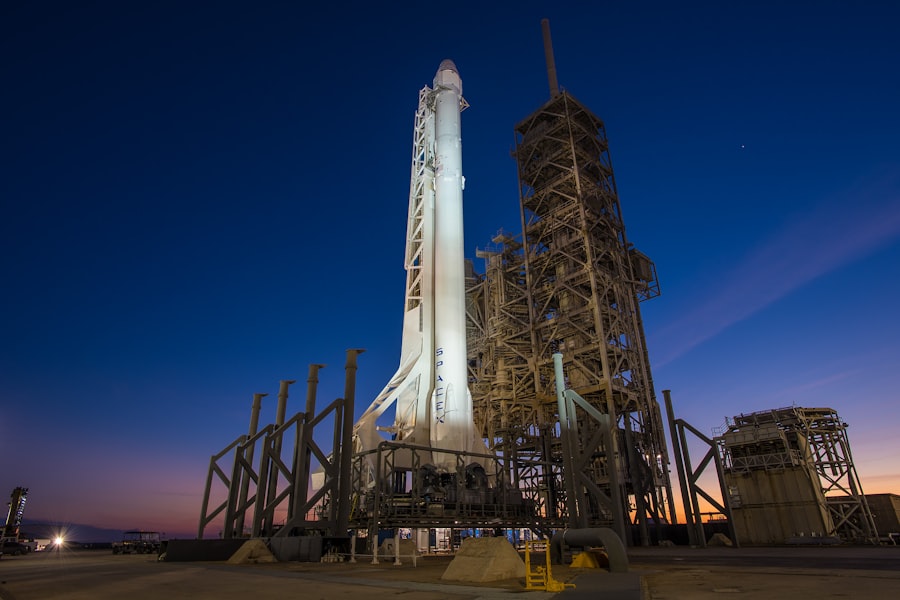SpaceX, founded in 2002 by Elon Musk, has emerged as a transformative force in the aerospace industry, redefining the parameters of space exploration and commercial space travel. The company’s inception was driven by Musk’s vision of reducing space transportation costs and enabling the colonization of Mars. From its early days, SpaceX faced skepticism from industry veterans who doubted the feasibility of a private company succeeding in a domain traditionally dominated by government agencies.
However, through a combination of innovative engineering, strategic risk-taking, and a relentless pursuit of ambitious goals, SpaceX has not only established itself as a leader in the field but has also inspired a new generation of entrepreneurs and engineers. The company’s first significant milestone came with the successful launch of the Falcon 1 rocket in 2008, making it the first privately developed liquid-fueled rocket to reach orbit. This achievement was pivotal, as it demonstrated that private entities could compete with established government programs.
Following this success, SpaceX continued to innovate, developing the Falcon 9 rocket and the Dragon spacecraft, which have since become workhorses for NASA and commercial satellite launches. The successful resupply missions to the International Space Station (ISS) marked a turning point, showcasing SpaceX’s capabilities and solidifying its reputation as a reliable partner in space exploration.
Key Takeaways
- Space X has revolutionized space travel with its pioneering advancements and ambitious goals.
- The company’s vision for the future includes colonizing Mars and making space travel more accessible.
- Space X’s technological innovations, such as reusable rockets and the Starship spacecraft, have significantly advanced space exploration.
- Navigating the next frontier comes with challenges and opportunities, including regulatory hurdles and potential for scientific discoveries.
- Space X collaborates with other space agencies, such as NASA, to further space exploration and research.
The Vision for the Future: Space X’s Ambitious Goals
SpaceX’s vision extends far beyond launching satellites and resupplying the ISS; it encompasses a grand ambition to make humanity a multi-planetary species. Central to this vision is the Starship program, which aims to develop a fully reusable spacecraft capable of carrying humans to Mars and beyond. Musk envisions a future where millions of people can live on other planets, fundamentally altering the trajectory of human civilization.
This audacious goal is not merely about exploration; it is about ensuring the survival of humanity in the face of potential existential threats on Earth. To achieve this vision, SpaceX is focused on creating a sustainable infrastructure for interplanetary travel. The Starship is designed to be fully reusable, significantly reducing the cost of access to space.
Musk has articulated a vision where regular flights to Mars could become commonplace within the next few decades. This ambitious timeline is underpinned by ongoing developments in rocket technology and life support systems necessary for long-duration space travel. The company’s commitment to innovation is evident in its iterative design process, where each test flight provides valuable data that informs subsequent iterations of the spacecraft.
Advancements in Space Travel: Space X’s Technological Innovations

SpaceX has pioneered several technological advancements that have revolutionized space travel. One of the most significant innovations is the development of reusable rocket technology. The Falcon 9’s first stage is designed to return to Earth and land vertically after launch, allowing it to be refurbished and reused for multiple missions.
This breakthrough has drastically reduced launch costs and increased the frequency of space missions. In fact, as of late 2023, SpaceX has successfully landed and reused Falcon 9 boosters over 100 times, setting a new standard for cost-effective space transportation. Another notable advancement is the integration of advanced materials and manufacturing techniques into rocket design.
SpaceX employs a unique combination of carbon fiber composites and aluminum alloys to create lightweight yet robust structures for its rockets. Additionally, the company has embraced additive manufacturing, or 3D printing, to produce complex components with greater efficiency and precision. This approach not only accelerates production timelines but also allows for rapid prototyping and testing of new designs.
The Raptor engine, which powers the Starship, exemplifies this innovation; it utilizes advanced materials and manufacturing processes that enhance performance while reducing costs.
Challenges and Opportunities: Navigating the Next Frontier
| Challenges | Opportunities |
|---|---|
| Rapid technological advancements | New markets and industries to explore |
| Global economic uncertainty | Diversification and innovation |
| Environmental sustainability | Green technologies and renewable energy |
| Workforce automation | Skills development and new job opportunities |
Despite its remarkable achievements, SpaceX faces numerous challenges as it navigates the complexities of space exploration. One significant hurdle is the regulatory landscape governing space travel. As private companies increasingly participate in space activities, regulatory frameworks must evolve to address safety concerns, orbital debris management, and international cooperation.
SpaceX has engaged with various regulatory bodies, including the Federal Aviation Administration (FAA), to ensure compliance while advocating for policies that facilitate innovation and growth in the commercial space sector. Moreover, as SpaceX prepares for missions to Mars and beyond, it must address the myriad technical challenges associated with long-duration space travel. These include developing life support systems capable of sustaining human life in harsh environments, ensuring radiation protection during interplanetary journeys, and creating sustainable habitats on other planets.
Each challenge presents an opportunity for innovation and collaboration with experts across various fields, from aerospace engineering to biology and environmental science.
Space X and Collaboration: Working with Other Space Agencies
Collaboration has been a cornerstone of SpaceX’s strategy since its inception. The company has forged partnerships with NASA and other international space agencies to advance shared goals in space exploration. NASA’s Commercial Crew Program is a prime example of this collaboration; SpaceX’s Crew Dragon spacecraft has successfully transported astronauts to and from the ISS as part of this initiative.
This partnership not only demonstrates the viability of public-private collaboration but also highlights how SpaceX’s innovations can complement traditional government-led space programs. In addition to NASA, SpaceX has engaged with international partners such as the European Space Agency (ESA) and various commercial satellite operators. These collaborations have facilitated knowledge exchange and resource sharing, enabling more efficient mission planning and execution.
For instance, SpaceX’s ability to launch payloads at competitive prices has attracted numerous international clients seeking reliable access to space. As global interest in space exploration continues to grow, these collaborative efforts will be crucial in addressing shared challenges and maximizing opportunities for scientific discovery.
The Future of Space Exploration: Potential Impacts on Earth and Beyond

The implications of SpaceX’s advancements extend far beyond the realm of space travel; they have the potential to reshape life on Earth as well. The development of satellite constellations like Starlink aims to provide global internet coverage, particularly in underserved regions. By leveraging low Earth orbit (LEO) technology, SpaceX seeks to bridge the digital divide and enhance connectivity worldwide.
This initiative could have profound effects on education, healthcare, and economic development in remote areas. Moreover, as humanity ventures into deeper space exploration, there are significant opportunities for scientific research that could yield insights into our own planet’s history and future. Missions to Mars may uncover evidence of past life or provide clues about planetary formation processes that could inform our understanding of Earth’s climate systems.
Additionally, advancements in propulsion technology could lead to breakthroughs in energy generation and resource utilization that benefit life on Earth.
Space X’s Role in Shaping the Next Generation of Space Travel
SpaceX’s influence on the future of space travel is profound, inspiring a new generation of scientists, engineers, and entrepreneurs. The company’s success has demonstrated that ambitious goals can be achieved through innovation and perseverance, encouraging young minds to pursue careers in STEM fields. Educational initiatives such as internships at SpaceX and outreach programs aimed at schools have further fueled interest in aerospace careers among students.
Moreover, SpaceX’s approach to iterative design and rapid prototyping serves as a model for future endeavors in various industries beyond aerospace. The principles of agility and adaptability that underpin SpaceX’s operations can be applied across sectors seeking to innovate quickly in response to changing market demands or technological advancements. As more companies enter the space industry inspired by SpaceX’s example, we can expect an influx of new ideas and technologies that will continue to push the boundaries of what is possible.
The Ethical and Moral Considerations of Space X’s Future Endeavors
As SpaceX embarks on its ambitious journey toward interplanetary colonization, ethical considerations come to the forefront. The prospect of establishing human settlements on Mars raises questions about planetary protection and our responsibility toward extraterrestrial environments. Ensuring that human activities do not contaminate other celestial bodies is paramount; this involves adhering to international treaties such as the Outer Space Treaty of 1967, which emphasizes the need for responsible exploration.
Additionally, there are moral implications associated with prioritizing resources for space exploration over pressing issues on Earth such as poverty, climate change, and social inequality. Critics argue that investments in space travel should not come at the expense of addressing urgent humanitarian needs. Balancing these priorities requires thoughtful dialogue among stakeholders—including governments, private companies like SpaceX, scientists, and civil society—to ensure that our pursuit of knowledge does not overshadow our obligations to our planet and its inhabitants.
In conclusion, while SpaceX stands at the forefront of a new era in space exploration with its groundbreaking technologies and ambitious goals, it must navigate complex ethical landscapes as it shapes humanity’s future among the stars. The journey ahead promises both challenges and opportunities that will require collaboration across disciplines and a commitment to responsible stewardship of both Earth and beyond.


